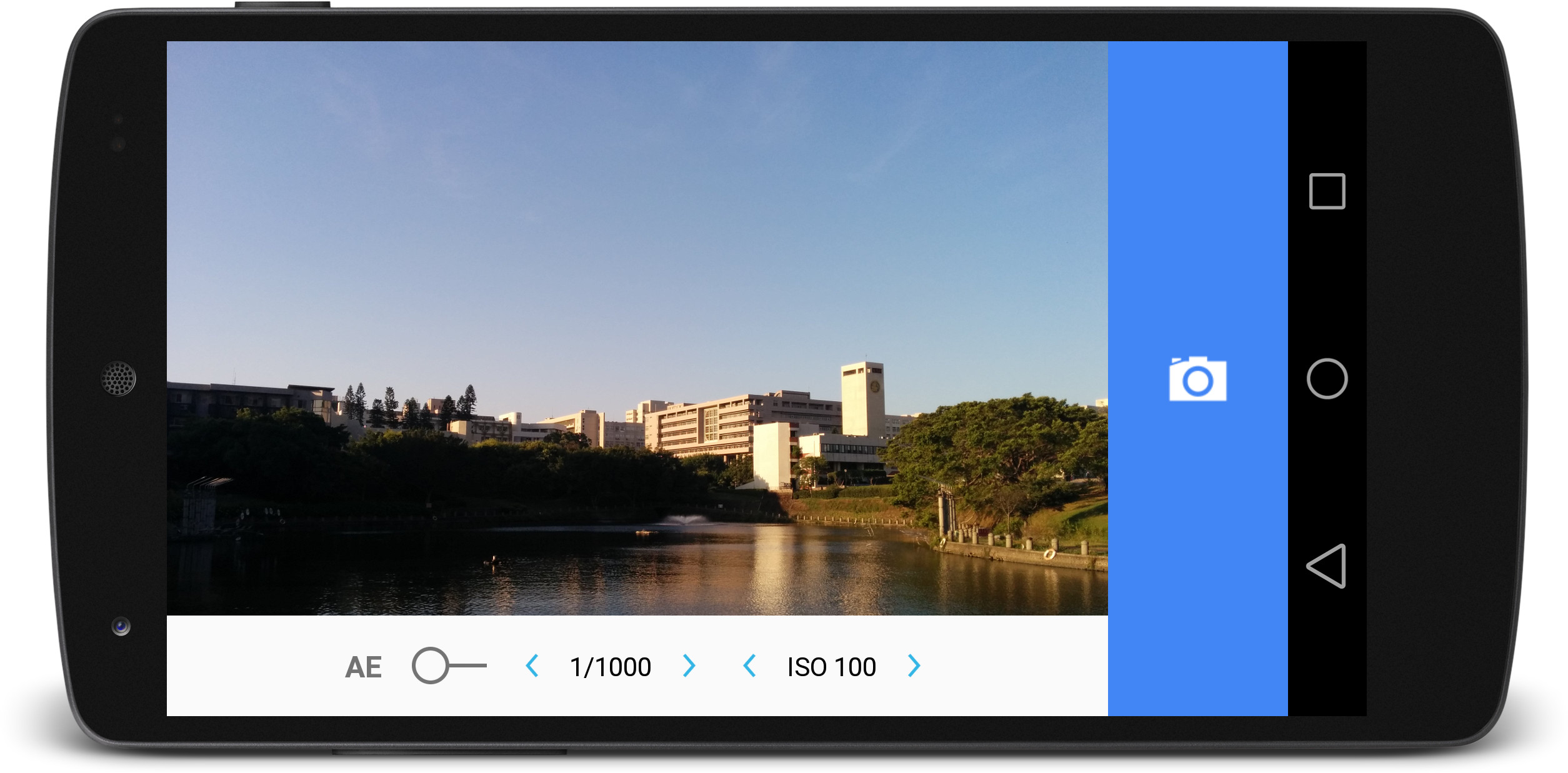L Camera is an open-source experimental camera app for Android L devices using the new android.hardware.camera2 API. Currently, the only supported device is Nexus 5 running Android Lollipop preview (LPX13D).
Please note that this app is intended to test and study new features of the camera API, it is not for general uses as it lacks many basic camera features (location tagging, white balance, photo review, flash control, etc).
See what you can achieve on the Nexus 5 with the new API.
- True manual focus (adjustable focus distance)
- Manual exposure time (0.8", 1/2, 1/4, 1/6, 1/8, 1/15, 1/30, 1/60, 1/100, 1/125, 1/250, 1/500, 1/1000, 1/2000, 1/4000, 1/8000, 1/16000)
- Manual ISO (100, 200, 400, 800, 1600, 3200, 6400, 10000)
- DNG output support
- 30-fps full-resolution burst capture with focus stacking & exposure bracketing in DNG
- 30-fps full-resolution video recording
- Material design
You can either install the pre-built debug APK (lcamera-debug.apk) found in the repository, or build and install the APK by yourself.
Just use it like any camera! Tap the floating button on the left-bottom corner to bring up settings:
- Focus
- Auto Focus: Whether the auto focus mechanism is enabled (tap on the preview to focus on a specific point).
- Focus Distance: Manually control focus distance if auto focus is turned off.
- Exposure
- Auto Exposure: Whether auto exposure and auto white balance routines are enabled (tap on the preview to start a metering sequence).
- Shutter Speed: Control the exposure time. (Setting a slow shutter speed will affect preview frame rate)
- ISO: Control the sensitivity of the sensor.
- Burst
- Burst: Control whether burst capturing is enabled. If enabled, the camera will capture 7 DNG images at maximum resolution at 30 fps. (Note that JPEG output is disabled during burst capturing.)
- Focus Stacking: If enabled, the camera will capture a series of images ranging from infinity focus and to the nearest focus distance possible.
- Exposure Bracketing: If enabled, the camera will capture a series of 7 images ranging from -3 to +3 EV of the standard expousre. (Only the shutter speed is varied, the ISO stays the same)
- Photo/Video: Switch between photo capturing and video recording mode. The video is recorded at maximum resolution (3264x2448) at 30 fps (may be lower if you choose a slow shutter speed), encoded with H.264 at 65mbps for video and 44.1khz 320kbps AAC-LC for audio in MP4 container. Focus distance and exposure are adjustable during recording.
If you are looking for a stopwatch to test the burst capture feature, check out this jsfiddle.
After capturing, output files will be saved to the /sdcard/DCIM/Camera/ directory. Note that each DNG image is 15.36 MiB in size, so make sure you have plenty of free space available!
Most RAW post-processing programs should be able to open them. While Adobe Lightroom is probably the most popular RAW editor, both darktable (Linux, Mac) and RawTherapee (Windows, Linux, Mac) are both free alternatives that also offer very powerful editing capabilities.
Make sure the downloaded apk is not corrupted, as it seems some browsers download GitHub's webpage instead of the actual apk. You must also have the latest Lollipop preview (LPX13D) running on your Nexus 5.
Check pkmx/lcamera#4 for current progress.
No.
Open an issue (one per feature please) on the tracker and I will see what I can do. However, the priority of development is investigating new ways to use the camera hardware rather than reimplement features that have been possible, or things that can be done in post-processing.
I get the "Unable to open camera (1)" errors while opening L Camera and the camera cannot be used by any apps.
There appears to be a problem with device locking and camera. Ususally, you can solve this problem removing L Camera from the recent apps list. If that doesn't work and you have both root and busybox installed, you can fix this by running kill $(pidof mediaserver) in a root shell.
The app is written in the Scala programming language and uses the following libraries/tools:
- SBT: build tool.
- Android SDK Plugin for SBT: for building Android apps with SBT.
- Scaloid: for UI layout and various helpers.
- Scala.Rx: for reactive value propagation.
- Floating Action Button: for the floating action button (FAB) featured in material design.
You must have both scala 2.11.2 and sbt >= 0.13 installed.
To build the app (the resulting APK will be placed in the bin/ directory):
$ sbt package
To build and run the app on device (assuming you have adb and developer mode enabled):
$ sbt run
To see debug outputs, set allowed logging priority of lcamera tag to DEBUG:
$ adb shell setprop log.tag.lcamera DEBUG
Please report any bugs or feature requests on GitHub's issue tracker.
This program is free software: you can redistribute it and/or modify
it under the terms of the GNU General Public License as published by
the Free Software Foundation, either version 3 of the License, or
(at your option) any later version.
This program is distributed in the hope that it will be useful,
but WITHOUT ANY WARRANTY; without even the implied warranty of
MERCHANTABILITY or FITNESS FOR A PARTICULAR PURPOSE. See the
GNU General Public License for more details.
You should have received a copy of the GNU General Public License
along with this program. If not, see <http://www.gnu.org/licenses/>.
